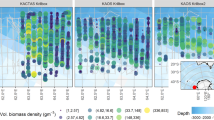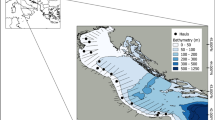Abstract
Ice krill is the keystone species in the neritic ecosystem in the Southern Ocean, where it replaces the more oceanic Antarctic krill. It is essential to understand the variation of target strength (TS in dB re 1 m2) with the different body size to accurately estimate ice krill stocks. However, there is comparatively little knowledge of the acoustic backscatter of ice krill. The TS of individual, formalin-preserved, tethered ice krill was measured in a freshwater test tank at 38, 120, and 200 kHz with a calibrated split-beam echo sounder system. Mean TS was obtained from 21 individual ice krill with a broad range of body lengths (L: 13–36 mm). The length (L, mm) to wet weight (W; mg) relationship for ice krill was W=0.001218×103 × L 3.53 (R 2 =0.96). The mean TS-to-length relationship were TS38 kHz =−177.4+57log10 (L), (R 2 = 0.86); TS120 kHz = −129.9+31.56log10 (L), (R 2 =0.87); and TS200 kHz =−117.6+24.66log10 (L), (R 2 =0.84). Empirical estimates of the relationship between the TS and body length of ice krill were established at 38, 120, and 200 kHz and compared with predictions obtained from both the linear regression model of Greene et al. (1991) and the Stochastic Distorted Wave Born Approximation (SDWBA) model. This result might be applied to improve acoustic detection and density estimation of ice krill in the Southern Ocean. Further comparative studies are needed with in situ target strength including various body lengths of ice krill.
Similar content being viewed by others
References
Amakasu K, Furusawa M. 2006. The target strength of Antarctic krill (Euphausia superba) measured by the split-beam method in a small tank at 70 kHz. ICES J. Mar. Sci., 63: 36–45.
Anderson V C. 1950. Sound scattering from a fluid sphere. J. Acoust. Soc. Am., 22: 426–431.
Azzali M, Leonori I, Biagiotti I, De Felice A, Angiolillo M, Bottaro M, Vacchi M. 2010. Target strength studies on Antarctic silverfish (Pleuragramma antarcticum) in the Ross Sea. CCAMLR Science, 17: 75–104.
Azzali M, Leonori I, De Felice A, Russo A. 2006. Spatialtemporal relationships between two euphausiid species in the Ross Sea. Chem. Ecol., 22: 219–233.
BioSonics. 2005. User Guide; Visual Acquisition, version 5.0. Seattle. p.64.
Bottino N R. 1974. The fatty acids of Antarctic phytoplankton and Euphausiids. Fatty acid exchange among levels of the Ross Sea. Mar. Biol., 27: 197–204.
Bushuev S G. 1986. Feeding of Minke whales, Balaenoptera acutorostrata, in the Antarctic. Rep. Int. Whal. Commun., 36: 241–245.
CCAMLR. 2007. Report of the twenty sixth meeting of the Scientific Committee. SC-CAMLR-XXVI, Commission for the Conservation of Antarctic Marine Living Resources, Hobart, Australia.
Chu D, Foote K G, Stanton T K. 1993. Further analysis of target strength measurements of Antarctic krill at 38 and 120 kHz: comparison with deformed cylinder model and inference of orientation distribution. J. Acoust. Soc. Am., 93: 2 985–2 988.
Chu D, Wiebe P H. 2005. Measurements of sound-speed and density contrasts of zooplankton in Antarctic waters. ICES J. Mar. Sci., 62: 818–831.
Demer D A, Conti S G. 2005. New target-strength model indicates more krill in the Southern Ocean. ICES J. Mar. Sci., 62: 25–32.
Foote K G, Everson I, Watkins J L, Bone D G. 1990. Target strengths of Antarctic krill (Euphausia superba) at 38 and 120 kHz. J. Acoust. Soc. Am., 87(1): 16–24.
Foote K G, Knudsen H P, Vestnes G, MacLennan D N, Simmonds E J. 1987. Calibration of acoustic instruments for fish density estimation: a practical guide, cooperative research report. Int. Coun. Exp. Sea, 144: 1–69.
Greene C H, Stanton T K, Wiebe P H, McClatchie S. 1991. Acoustic estimates of Antarctic krill. Nature, 349: 110.
Greenlaw C F. 1977. Backscattering spectra of preserved zooplankton. J. Acoust. Soc. Am., 62: 44–52.
Hewitt R P, Demer D A. 1991. Krill abundance. Nature, 353: 310.
Hewitt R P, Watkins J L, Naganobu M, Tshernyshkov P, Brierley A S, Demer D A, Kasatkina S, Takao Y, Goss C, Malyshko A, Brandon M A, Kawaguchi S, Siegel V, Trathan P N, Emery J H, Everson I, Miller D G M. 2002. Setting a precautionary catch limit for Antarctic krill. Oceanogr., 15: 26–33.
Hosie G W. 1994. The macrozooplankton communities in the Prydz Bay region, Antarctica. In: El-Sayed S Z ed. Southern Ocean Ecology: The BIOMASS Perspective. Cambridge Univ. Press, USA. p.93–123.
Johnson R K. 1977. Sound scattering from a fluid sphere revisited. J. Acoust. Soc. Am., 61: 375–377.
Madureira L S P, Everson I, Murphy E J. 1993. Interpretation of acoustic data at two frequencies to discriminate between Antarctic krill (Euphausia superba Dana) and other scatterers. J. Plankton Res., 15: 787–802.
McGehee D E, O’Driscoll R L, Traykovski M. 1998. Effects of orientation on acoustic scattering from Antarctic krill at 120 kHz. Deep Sea Res. Part II, 45: 1 273–1 294.
Medwin H, Caly C S. 1998. Fundamental of Acoustical Oceanography. Academic Press. p.712.
Morris D J, Watkins J L, Ricketts C, Buchholz F, Priddle J. 1988 An assessment of the merits of length and weight measurements of Antarctic krill Euphausia superba. Br. Antarct. Surv. Bull., 79: 27–50.
Pakhomov E A, Perissinotto R, Froneman P W. 1998. Abundance and trophodynamics of Euphausia crystallorophias in the shelf region of the Lazarev Sea during austral spring and summer. J. Marine Syst., 17: 313–324.
Richter K E. 1985. Acoustic scattering at 1.2 MHz from individual zooplankters and copepod populations. Deep Sea Res., 32: 149–161.
Sala A, Azzali M, Russo A. 2002. Krill of the Ross Sea: distribution, abundance and demography of Euphausia superb a and Euphausia crystallorophias during the Italian Antarctic Expedition (January–February 2000). Sci. Mat., 66: 123–133.
SC-CAMLR. 2005. Report of the First Meeting of the Subgroup on Acoustic Survey and Analysis Method (SGASAM). In: Report of the Twenty-fourth Meeting for the Scientific Committee (SC-CAMLR-XXIV), Annex 6. CCAMLR, Hobart, Australia. p.563–585.
Smith J N, Ressler P H, Warren J D. 2010. Material properties of euphausiids and other zooplankton from the Bering Sea. J. Acoust. Soc. Am., 128: 2 664–2 680.
Soule M, Barange M, Solli H, Hampton I. 1997. Performance of a new phase algorithm for discriminating between single and overlapping echoes in a split-beam echo sounder. ICES J. Mar. Sci., 54: 934–938.
Steedman H F. 1976. General and applied data on formaldehyde fixation and preservation of marine zooplankton. In: Steedman H F ed. Zooplankton Fixation and Preservation. UNESCO Press. p.103–154.
Steedman H F. 1976. Osmotic pressure in fixation and preservation. In: Steedman H F ed. Monographs on Oceanographic Methodology: 4. Zooplankton Fixation and Preservation. UNESCO Press, Paris. p.186–188.
Author information
Authors and Affiliations
Corresponding author
Additional information
Supported by the Korea Polar Research Institute (No. PP14020) and the Korea Institute of Ocean Science and Technology (No. PN65250)
Rights and permissions
About this article
Cite this article
La, H.S., Lee, H., Kang, D. et al. Ex situ echo sounder target strengths of ice krill Euphausia crystallorophias . Chin. J. Ocean. Limnol. 33, 802–808 (2015). https://doi.org/10.1007/s00343-015-4064-3
Received:
Accepted:
Published:
Issue Date:
DOI: https://doi.org/10.1007/s00343-015-4064-3




